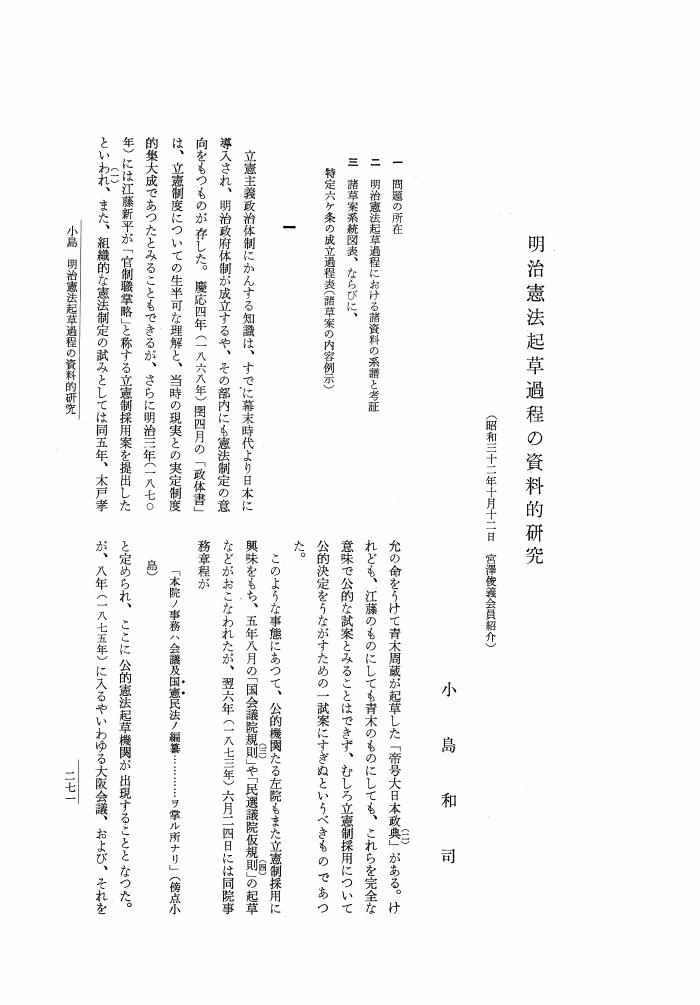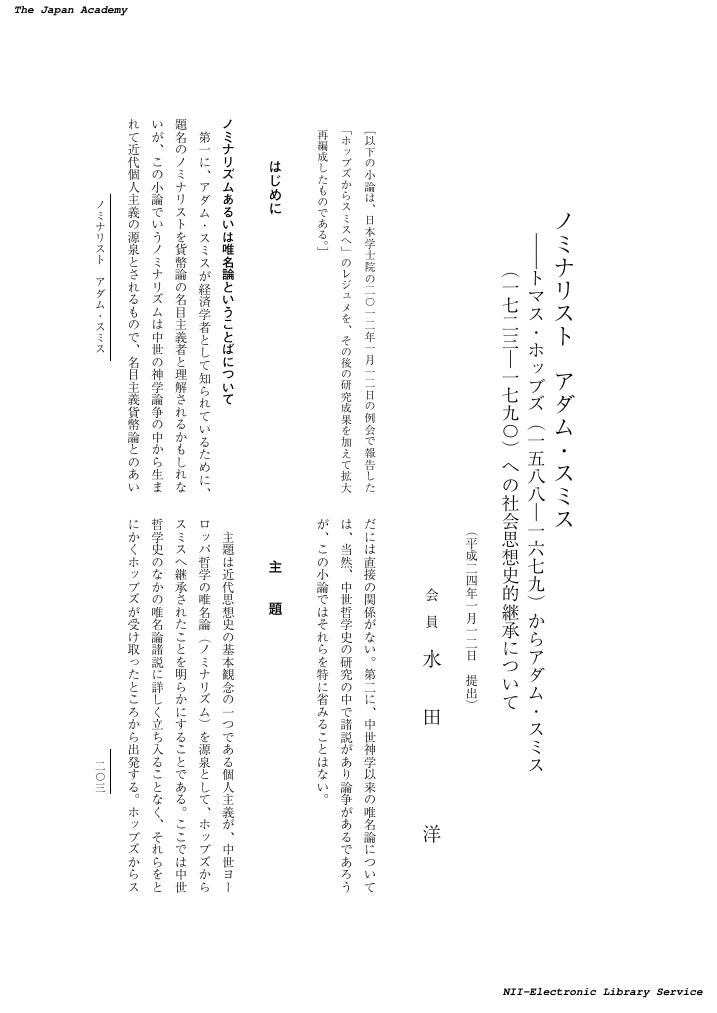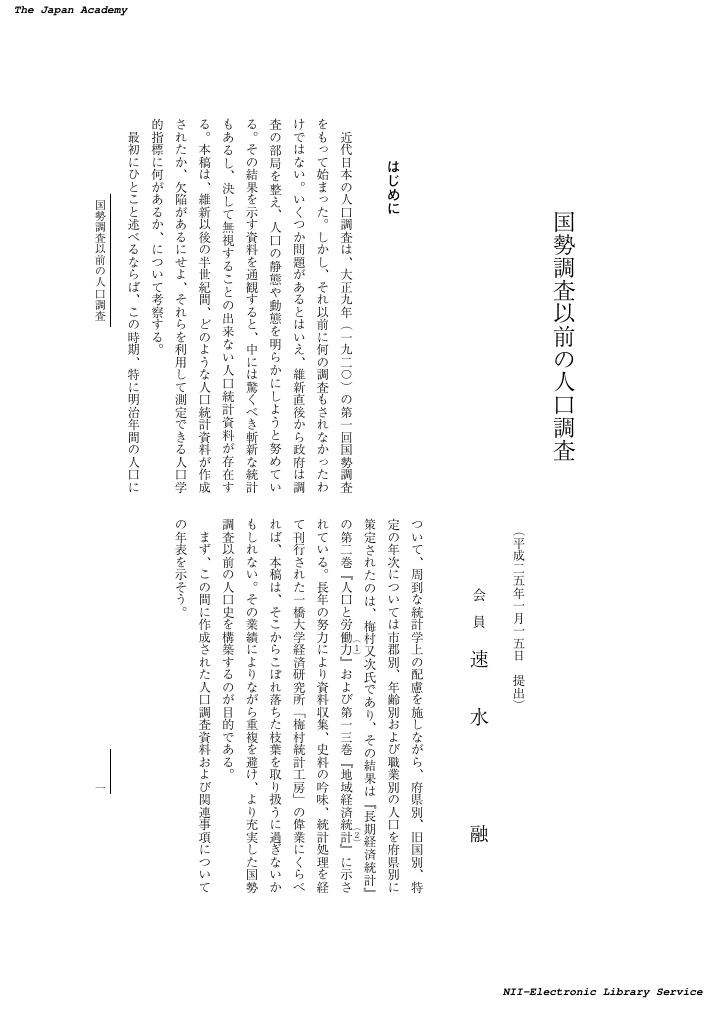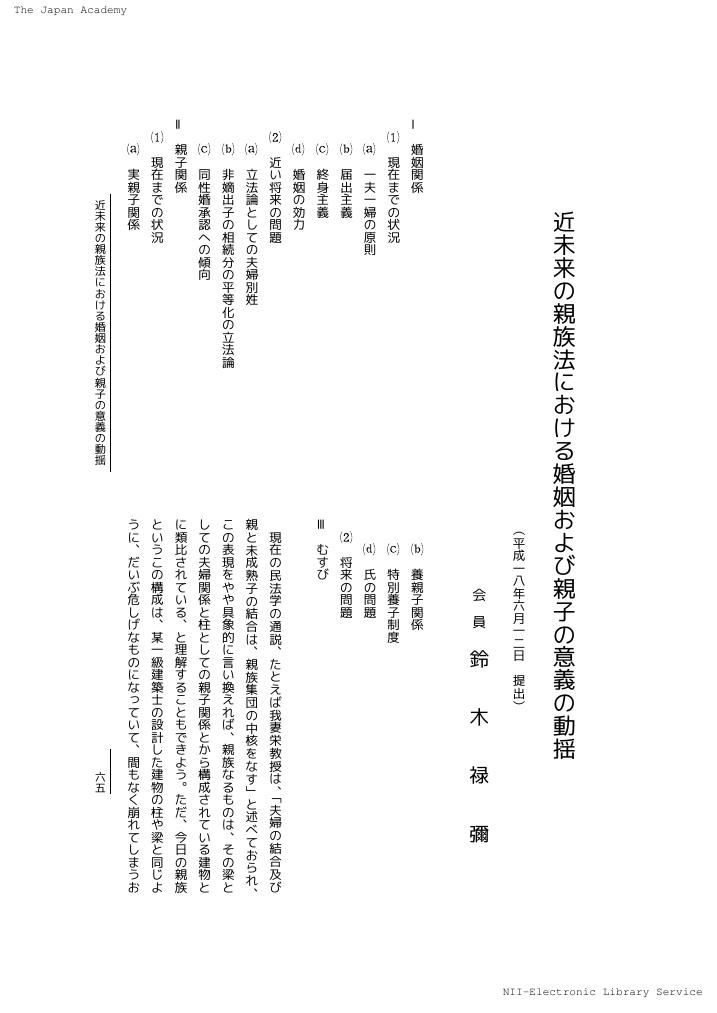- 著者
- 上野 善道
- 出版者
- 日本学士院
- 雑誌
- 日本學士院紀要 (ISSN:03880036)
- 巻号頁・発行日
- vol.40, no.3, pp.215-250, 1985
This paper is an entirely revised version of the author's article“The Geographical Distribution of Japanese Accents”in S. A. Wurm and Shiro Hattori (1983). The geographical distribution is made more accurate, and his hypothetical view on the genealogical relationships among Japanese accents is expounded this time.<br>In part (1), the following three accent types are treated: Ibuki-jima dialect (1/2/3/4/5), Manabe type dialects (1•5/2/3/4) and Sanuki type dialects (1•3/2/4/5). After their accentual systems and the geographical dis-tribution are described, proto-Manabe accent and proto-Sanuki accent are reconstructed as table 2 (p. 229) and table 25 (p. 244), respectively. Ibuki-jima is the only dialect that preserves all the oppositions supposed to have existed in the protolanguage of all dialects, but the tonetic substances (tone values) are considered to have changed somewhat from the proto-accent.
1 0 0 0 OA 明治憲法起草過程の資料的研究 (昭和三十二年十月十二日 宮澤俊義会員紹介)
- 著者
- 小島 和司
- 出版者
- 日本学士院
- 雑誌
- 日本學士院紀要 (ISSN:03880036)
- 巻号頁・発行日
- vol.15, no.3, pp.271-299, 1957 (Released:2007-05-30)
1 0 0 0 OA 競争政策の方向と新独占禁止法 : 改正法と指針改定の位置づけと評価
- 著者
- 宮澤 健一
- 出版者
- 日本学士院
- 雑誌
- 日本學士院紀要 (ISSN:03880036)
- 巻号頁・発行日
- vol.63, no.1, pp.49-75, 2008-09
1 0 0 0 投票参加の理論と実証--最近の政治学的研究から
- 著者
- 三宅 一郎
- 出版者
- 日本學士院
- 雑誌
- 日本學士院紀要 (ISSN:03880036)
- 巻号頁・発行日
- vol.59, no.2, pp.67-83, 2005-01
1 0 0 0 OA 汪輝祖 : 人とその時代
- 著者
- 滋賀 秀三
- 出版者
- 日本学士院
- 雑誌
- 日本學士院紀要 (ISSN:03880036)
- 巻号頁・発行日
- vol.64, no.1, pp.1-23, 2009 (Released:2017-04-05)
1 0 0 0 中世豪族館城の研究--関東地方に於ける館址の実測とその復原試論
- 著者
- 小室 栄一
- 出版者
- 日本学士院
- 雑誌
- 日本学士院紀要 (ISSN:03880036)
- 巻号頁・発行日
- vol.17, no.1, 1960-04
1 0 0 0 OA 詩人カビールの思想的特徴 (平成八年二月一三日 提出)
- 著者
- 中村 元
- 出版者
- The Japan Academy
- 雑誌
- 日本學士院紀要 (ISSN:03880036)
- 巻号頁・発行日
- vol.51, no.1, pp.45-69, 1996 (Released:2007-06-22)
It has been the topic of debate among scholars and thinkers whether modern thoughts as can be noticed in the West did exist in India before Western thoughts were introduced into India.When scholars and thinkers take up Indian philosophy, they discuss the thoughts in philosophical texts which are relevant to darsanas; such as the Nyaya-Vaiseshika or Vedanta schools. They tend to disregard philosophical thoughts as were expressed and represented by poets or religious leaders in the modern period.However, in my eyes modern thoughts which are occasionally more radical than those expressed by modern thinkers of the West are noticed in the poems of some Indian thinkers of the same period.One of the most noteworthy thinkers was Kabir the poet (1440-1518 A. D.). His thoughts are not set forth, nor discussed by authors of ordinary“History of Indian philosophy”and so on. They discuss chiefly darsanas.However, as the remarkable thinker of India at the dawn of modern age, I am going to discuss the philosophical thought of Kabir.I. To our astonishment, he was an explicit egalitarian. He denied all the distinctions and discriminations among various classes or castes.II. He was thoroughgoing in the respect of iconoclasm. He denied the significance of all idols.III. The significance of religion can be noticed in the internal character. The significance of all the holy scriptures was denied.IV. God resides only within one's mind. The difference among various religions was denied. Practice of all traditional rituals is useless.V. Erudition about religious scriptures is useless. He encouraged pratical and realistic scholarship.VI. We should rely upon experiences alone. He expressed pragmatic views.VII. To be a human being should be placed in viewing things. Human body should be taken care of.VIII. The spirit of love should be extended beyond human beings. This worldly, secular attitude concerning daily life should be emphasized. Family life is most important.IX. The yawning for God can be compared to sexual love. Otherworldly religious practice was denied.
1 0 0 0 OA Nicht, dass ich wüsste.をめぐって
- 著者
- 岩崎 英二郎
- 出版者
- 日本学士院
- 雑誌
- 日本學士院紀要 (ISSN:03880036)
- 巻号頁・発行日
- vol.65, no.3, pp.151-191, 2011 (Released:2017-03-31)
- 著者
- 水田 洋
- 出版者
- 日本学士院
- 雑誌
- 日本學士院紀要 (ISSN:03880036)
- 巻号頁・発行日
- vol.68, no.3, pp.203-248, 2014 (Released:2017-04-05)
1 0 0 0 OA 国勢調査以前の人口調査
- 著者
- 上野 善道
- 出版者
- The Japan Academy
- 雑誌
- 日本學士院紀要 (ISSN:03880036)
- 巻号頁・発行日
- vol.40, no.3, pp.215-250, 1985 (Released:2007-06-22)
This paper is an entirely revised version of the author's article“The Geographical Distribution of Japanese Accents”in S. A. Wurm and Shiro Hattori (1983). The geographical distribution is made more accurate, and his hypothetical view on the genealogical relationships among Japanese accents is expounded this time.In part (1), the following three accent types are treated: Ibuki-jima dialect (1/2/3/4/5), Manabe type dialects (1•5/2/3/4) and Sanuki type dialects (1•3/2/4/5). After their accentual systems and the geographical dis-tribution are described, proto-Manabe accent and proto-Sanuki accent are reconstructed as table 2 (p. 229) and table 25 (p. 244), respectively. Ibuki-jima is the only dialect that preserves all the oppositions supposed to have existed in the protolanguage of all dialects, but the tonetic substances (tone values) are considered to have changed somewhat from the proto-accent.
1 0 0 0 イギリス・ルネサンス(文学)における国家理性
- 著者
- 玉泉 八州男
- 出版者
- 日本学士院
- 雑誌
- 日本學士院紀要 (ISSN:03880036)
- 巻号頁・発行日
- vol.71, no.3, 2017
As a language of politics, ‘reason of state’ has undergone development and transformation. It originally meant in Botero that a state was endowed with its own raison d’ etre which overrode all moral and legal considerations. In the English Renaissance, however, this political language of prudence was expanded to include not only its synonym, arcana imperii, or mysteries of state, but also a Phoenix image and the Actaeon myth.<br> According to F. Meinecke, a German historian, this ‘noble sport’ became common in Italy about the second quarter of the seventeenth century, as a subject for conversations among the barbers and other base craftmen. In England, its vulgarization began a little earlier at the turn of the century, when Ben Jonson used the term ‘de stato’ in his satirical comedy, Cynthia’s Revels (1600). By the caricaturized portrait of Sir Politic Would-be, the leading figure in the subplot of Volpone (1610), he also showed us how much a Quiotic man of the Renaissance such as he was enamored and distracted with the matters of state.<br> On the other hand, Edmund Spenser refers to the ‘somewhat’ of Queen Elizabeth alias Diana as one of arcana imperii, and tells us how the spell the Queen had casted over him was broken when Spenser-Faunus peeped at her middle-aged naked body. Thus ‘breaking forth in laughter’ Spenser fashioned himself from a faithful subject of the Shepherds’ Nation into a revolutionary ‘subject’.<br> To John Donne, a failure in life due to his religious faith and secret marriage, the trope doesn’t imply the Queen’s deformed body, but his own world of love. He tries in vain to persuade his newlywed wife to live an eternal life with him like the Phoenix that resurrects as often as it dies. So he yearns for death to be buried in a well-wrought urn, and be canonized for love. But as he grows old, he becomes so anxious for recognition by the world that he changes his faith to Anglicanism, with the result that he denies the existence of the Phoenix itself. He also confesses in his sermon that arcana imperii have also turned into something negative and harmful at once.<br> By 1621, when the reason of state became a part of the arsenal of arguments on the side of the Parliament, the execution of Sir Walter Raleigh had already been carried out as a scapegoat of the King’s pro-Spanish policy. In The History of the World, one of the best-sellers of the seventeenth century, Raleigh mentioned nothing definitely about what the King’s Prerogative or the reason of state should be like, but it is quite clear he thought it as a matter of course ever since the Norman dynasty for the king to consult with the Parliament on anything really important to the state.<br> The popularity of that political language, which gave poets in the English Renaissance an occasion suitable for their self-aggrandizement, has not lasted long since then. Apart from people’s allergy to the bitter Civil War, some other reasons can be considered. One is the disappearance, with the dusk of the Renaissance, of a man with the Actaeon-like mentality who will gladly be hunted to death by his own passions. The other is the fact that it was originally made of too contradictory elements such as ‘honestum’ and ‘utile’ to live long in England, where the ‘jealousy of trade’ soon became prevalent in the eighteenth century.
1 0 0 0 OA 歴史の限界 (昭和四十四年十二月十二日 提出)
- 著者
- 三宅 剛一
- 出版者
- 日本学士院
- 雑誌
- 日本學士院紀要 (ISSN:03880036)
- 巻号頁・発行日
- vol.28, no.1, pp.9-13, 1970 (Released:2007-05-30)
1 0 0 0 OA 「群書治要」の残簡 (昭和二十六年四月十二日報告)
- 著者
- 太田 晶二郎
- 出版者
- 日本学士院
- 雑誌
- 日本學士院紀要 (ISSN:03880036)
- 巻号頁・発行日
- vol.9, no.1, pp.41-48, 1951 (Released:2007-05-30)
1 0 0 0 OA アリストテレス「アテナイ人の国制」について (昭和四十八年四月十二日 提出)
- 著者
- 村川 堅太郎
- 出版者
- 日本学士院
- 雑誌
- 日本學士院紀要 (ISSN:03880036)
- 巻号頁・発行日
- vol.31, no.3, pp.121-139, 1973 (Released:2007-05-30)
1 0 0 0 OA 近未来の親族法における婚姻および親子の意義の動揺
- 著者
- 鈴木 禄彌
- 出版者
- 日本学士院
- 雑誌
- 日本學士院紀要 (ISSN:03880036)
- 巻号頁・発行日
- vol.61, no.2, pp.65-79, 2007 (Released:2017-04-05)
1 0 0 0 OA 東大寺法華堂天蓋の奈良時代墨書
- 著者
- 東野 治之
- 出版者
- 日本学士院
- 雑誌
- 日本學士院紀要 (ISSN:03880036)
- 巻号頁・発行日
- vol.72, no.3, pp.77, 2018 (Released:2018-05-14)
Hokke-do Hall at Todaiji Temple is widely known as a monument built in the beginning of the 8th century, and it is also famous for the many original Buddist statues that are still there. In 2015, construction work was carried out on the building to reinforce it against earthquakes. During this process, a number of ancient writings written in India ink were discovered, including writings from the original construction. These writings were discovered in the canopy within the hall, under the floorboards, and in the halo of the main statue. These writings contain some things of great historical significance, and yet, due to various circumstances, we have reached the present day without making any official report. At the request of the Agency for Cultural Affairs, I have looked at almost all of these writings, and I have received digital photos of them. This paper examines the results of deciphering a particularly important writing, the writing in India ink found in the canopy, and it describes its significance in cultural history. Below is a summary of this. In order from east to west, the canopies in Hokke-do Hall are called the eastern canopy, the central canopy, and the western canopy. When they were created, they were each different, and looking at them from the perspective of art, the eastern canopy is a work of art from the Nara period (with modern repairs that have been done to it), the central canopy is from the Kamakura period, and the western canopy is from the time of original construction, the Nara period. The most notable of the discovered India-ink writings were those from the western canopy. The era that those writings came from was determined based on the construction situation of the canopy, and they seem to have been written after the materials for the canopy were prepared but before the canopy was completed. Some interesting content from those writings included a phrase written in the style of Chinese poetry in two different places that means “last night I slept with a young unmarried woman, but the night was too short, and my love was not properly exhausted.” This sort of content—not appropriate for a Buddhist temple—written in scribbles or on practice writing paper in the style of Chinese poetry is not necessarily rare. For example, there are five words scribbled on the inside of the pedestal of the Shakyamuni triad in the main Hall of Houryuuji that was created around the year 623. Additionally, there are also some scribbles in the style of Chinese poetry that can be seen on the wooden writing plates from the end of the 7th century that were excavated from Asuka-ike site in Nara Prefecture. Both of these have content that suggests a rendezvous between a man and a woman, and the ideas and format seem consistent with the writings found in the canopy. The characters that partially remain, such as “beautiful,” “a bush warbler sings,” and “pleasant voice,” could also be part of a series, with these phrases written in the style of Chinese poetry. (View PDF for the rest of the abstract.)
1 0 0 0 国勢調査以前の人口調査
- 著者
- 速水 融
- 出版者
- 日本学士院
- 雑誌
- 日本學士院紀要 (ISSN:03880036)
- 巻号頁・発行日
- vol.68, no.1, pp.1-44, 2013
- 被引用文献数
- 1
1 0 0 0 OA 近世日本の人口構造と変動
- 著者
- 速水 融
- 出版者
- 日本学士院
- 雑誌
- 日本學士院紀要 (ISSN:03880036)
- 巻号頁・発行日
- vol.62, no.3, pp.285-309, 2008 (Released:2017-04-05)
1 0 0 0 OA 中世豪族館城の研究
- 著者
- 小室 栄一
- 出版者
- 日本学士院
- 雑誌
- 日本學士院紀要 (ISSN:03880036)
- 巻号頁・発行日
- vol.17, no.1, pp.75-129, 1959 (Released:2007-05-30)











